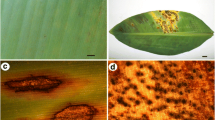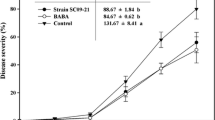Abstract
Citrus melanose is one of the most important diseases in orchards cultivating citrus in the world. Although the disease does not cause yield loss, the profitability of the infected fruits is often reduced in the fresh-market, resulting in economic loss. In this study, disease reduction was proven by pre-treatment with Pseudomonas putida strain THJ609-3. In order to illustrate mechanism of the disease reduction by the bacterial strain, the infection behaviors of Diaporthe citri and necrosis deposit of plant tissue were observed using a fluorescence microscope. On the leaves pre-treated with the strain THJ609-3, germination rates of D. citri conidia were significantly decreased compared to those of the untreated control. Scanning electron microscopical observations showed that bacterial cells were attached to the surface of fungal hyphae. Furthermore, morphological change of germ tubes of the conidia was detected. These results suggest that the disease reduction may be caused by the direct antifungal activity of the bacterial strain on the leaf surfaces.
Similar content being viewed by others
References
Agostini, J.P., Bushong, P.M., Bhatia, A., and Timmer, L.W. 2003. Influence of environmental factors on the severity of citrus scab and melanose. Plant Dis. 87, 1102–1106.
An, Y.J., Kang, S.C., Kim, K.D., Hwang, B.K., and Jeun, Y.C. 2010. Enhanced defense responses of tomato plants against late blight pathogen Phytophthora infestans by pre-inoculation with rhizobacteria. Crop Prot. 29, 1406–1412.
Bowles, D.J. 1990. Defense-related proteins in higher plants. Annu. Rev. Biochem. 59, 873–907.
Hayat, M.A. 1989. Chemical fixation, pp. 1–78. Principles and techniques of electron microscopy. Biological applications, 3rd ed. The Macmillan Press LTD.
Hur, K.H. and Park, S.K. 2005. Sporulation and dissemination of pycnidiospores of Diaporthe citri in yuzu tree (Citrus junos Sieb) in Jeonnam Area. Res. Plant Dis. 11, 16–20.
Hyun, J.W., Ko, S.W., Kim, D.H., Han, S.G., Kim, K.S., Kwon, H.M., and Lim, H.C. 2005. Effective usage of copper fungicides for environment-friendly control of citrus diseases. Res. Plant Dis. 11, 115–121.
Jeun, Y.C., Park, K.S., Kim, C.H., Fowler, W.D., and Kloepper, J.W. 2004. Cytological observations of cucumber plants during induced resistance elicited by rhizobacteria. Biol. Control 29, 34–42.
Jeun, Y.C., Sigrist, J., and Buchenauer, H. 2000. Biochemical and cytological studies on mechanisms of systemically induced resistance in tomato plants against Phytophthora infestans. J. Phytopathol. 148, 129–140.
Kim, Y.S., Choo, H.Y., Park, C.G., and Lee, D.W. 2005. Analysis of pesticide residues on sweet persimmon harvested from systemized orchards for exporting to USA. Korean J. Pesticide Sci. 9, 166–172.
Ko, Y.J., Kang, S.Y., and Jeun, Y.C. 2012. Suppression of citrus melanose on the leaves treated with rhizobacterial strains after inoculation with Diaporthecitri. Res. Plant Dis. 18, 331–337.
Kwon, H.M., Nam, K.W., Kim, K.S., Kim, D.H., Lee, S.C., and Hyun, J.W. 2003. Characterization of the causal fungus of citrus melanose, Diaphorthe citri isolated from blighted twigs of citrus in Jeju. Res. Plant Dis. 9, 153–158.
Lahlali, R., Peng, G., McGregor, L., Gossen, B.D., Hwang, S.F., and McDonald, M. 2011. Mechanisms of the biofungicide Serenade (Bacillus subtilis QST713) in suppressing clubroot. Biocontrol Sci. Technol. 21, 1351–1362.
Liu, W.W., Mu, W., Zhu, B.Y., DU, Y.C., and Liu, F. 2008. Antagonistic activities of volatiles from four strains of Bacillus spp. and Paenibacillus spp. against soil-borne plant pathogens. Agr Sci China. 7, 1104–1114.
Ma, Y., Chang, Z.Z., Zhao, J.T., and Zhou, M.G. 2008. Antifungal activity of Penicillium striatisporum Pst10 and its biocontrol effect on Phytophthora root rot of chilli pepper. Biol. Control 44, 24–31.
Martins, S.J., Medeiros, F.H.V., Souza, R.M., Resende, M.L.V., and Junior, P.M.R. 2013. Biological control of bacterial wilt of common bean by plant growth-promoting rhizobacteria. Biol. Control 66, 65–71.
Maurhofer, M., Hase, C., Meuwly, P., Mraux, J.P., and Defago, G. 1994. Induction of systemic resistance of tobacco to tobacco necrosis virus by the root-colonizing Pseudomonas fluorescens strain CHAO: influence of the gacA-gene and of pyoverdine production. Phytopathology 84, 139–146.
Mondal, S.N., Agostini, J.P., Zhang, L., and Timmer, L.W. 2004. Factors affecting phcnidium production of Diaporthe citri on detached citrus twigs. Plant Dis. 88, 379–382.
Mondal, S.N., Vicent, S., Reis, R.F., and Timmer, L.W. 2007. Saprophytic colonization of citrus twigs by Diaporthe citri and factors affecting phcnidial production and conidial survival. Plant Dis. 91, 387–392.
Nawrocka, J. and Malolepsza, U. 2013. Diversity in plant systemic resistance induced by Trichoderma. Biol Control. 67, 149–156.
Sang, M.K., Kim, E.N., Han, G.D., Kwack, M.S., Jeun, Y.C., and Kim, K.D. 2014. Priming-mediated systemic resistance in cucumber induced by Pseudomonas azotoformans GC-B19 and Paenibacillus elgii MM-B22 against Colletotrichum orbiculare. Phytopathology. Article in print.
Sowndrhrarajan, K., Marimuthu, S., and Manian, S. 2012. Biocontrol potential of phylloplane bacterium Ochrobactrum anthropi BMO-111 against blister blight disease of tea. J. Appl. Microbiol. 114, 209–218.
Timmer, L.W., Zitko, S.E., and Albrigo, L.G. 1998. Split application of copper fungicides improve control of melanose on grapefruit in Florida. Plant Dis. 82, 983–986.
Van Loon, L.C. 2007. Plant responses to plant growth-promoting rhizobacteria. Eur J. Plant Pathol. 119, 243–254.
Wei-wei, L.I.U., Wei, M.U., Bing-yu, Z.H.U., You-chen, D.U., and Feng, L.I.U. 2008. Antagonistic activities of volatiles from four strains of Bacillus spp. and Paenibacillus spp. against soil-borne plant pathogens. Agr. Sci. China 7, 1104–1114.
Whiteside, J.O. 2000. Melanose. In Timmer, L.W., Garnsey, S.M., and Grahan, J.H. (eds.), Compendium of citrus diseases. 2nd ed., pp. 28–29. The American Phytopathological Society, St. Paul, MN, USA.
Zehnder, G.W., Murphy, J.F., Sikora, E.J., and Kloepper, J.W. 2001. Application of rhizobacteria for induced resistance. Eur. J. Plant Pathol. 107, 39–50.
Author information
Authors and Affiliations
Corresponding author
Rights and permissions
About this article
Cite this article
Ko, Y.J., Kim, J.S., Kim, K.D. et al. Microscopical observation of inhibition-behaviors against Diaporthe citri by pre-treated with Pseudomonas putida strain THJ609-3 on the leaves of citrus plants. J Microbiol. 52, 879–883 (2014). https://doi.org/10.1007/s12275-014-4399-z
Received:
Revised:
Accepted:
Published:
Issue Date:
DOI: https://doi.org/10.1007/s12275-014-4399-z




